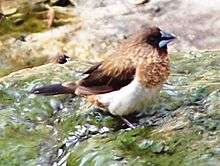White-rumped munia
| White-rumped munia | |
|---|---|
 | |
| Scientific classification | |
| Kingdom: | Animalia |
| Phylum: | Chordata |
| Class: | Aves |
| Order: | Passeriformes |
| Family: | Estrildidae |
| Genus: | Lonchura |
| Species: | L. striata |
| Binomial name | |
| Lonchura striata (Linnaeus, 1766) | |
| | |
| Core native range in green Northern populations (see text) not shown | |
| Synonyms | |
| |
The white-rumped munia or white-rumped mannikin (Lonchura striata), sometimes called striated finch in aviculture, is a small passerine bird from the family of waxbill "finches" (Estrildidae). These are close relatives of the true finches (Fringillidae) and true sparrows (Passeridae).
It is native to tropical continental Asia and some adjacent islands, and has been naturalized in some parts of Japan. Its domesticated hybrid descendant, the society finch or Bengalese finch, is found worldwide as a pet and a biological model organism.
Description

-_acuticauda_race_preening_after_bath_at_Narendrapur_W_IMG_4248.jpg)
The white-rumped munia is approximately 10 to 11 cm in length, with a stubby grey bill and a long black pointed tail. The adults are brown above and on the breast, and lighter below; the rump is white. There is some variation between the subspecies, but the sexes are almost impossible to distinguish in all subspecies; males have a more bulky head and bill.[2]
Subspecies include:[2][3][4][5][6]
- Lonchura striata acuticauda – northwestern white-rumped munia. Northern Indian mainland below c. 1,500 metres ASL, north through the Himalayas foothills of Bhutan and Nepal to the Dehradun region of Uttarakhand, India.
- Lonchura (striata) domestica – society finch. Domesticated; naturalized in Japan.
- A number of breeds have been developed, ranging from white through yellowish, grey, rufous and brown to almost black, with more or less lighter belly; piebald birds are common, and more fanciful breeds with crests or curled feathers are also available.
- Lonchura striata semistriata (Hume 1874) – Nicobar white-rumped munia. Car Nicobar and Central (Nancowry) group, Nicobar Islands
- Lonchura striata squamicollis – Chinese white-rumped munia. Southwestern China and adjacent regions.
- Lonchura striata striata (Linnaeus, 1766) – southwestern white-rumped munia. Southern Indian mainland
- Dark chocolate-brown above, white below.
Ecology


The white-rumped munia is a common resident breeder ranging from South Asia to southern China east to Taiwan, and through Southeast Asia south to Sumatra; it frequents open woodland, grassland and scrub, and is well able to adapt to agricultural land use. It is a gregarious bird which feeds mainly on seeds, moving through the undergrowth in groups and sometimes accompanying other birds such as puff-throated babblers (Pellorneum ruficeps). The nest is a large domed grass structure in a tree, bush or grass into which three to eight white eggs are laid.[2][5][6] They are also known to use abandoned nests of Baya weaver. They are often found near water and have been observed feeding on algae. It has been suggested that they obtain protein from their diet of algae often in the species Spirogyra, which grows in paddy fields.[7][8][9]
It is a common and widespread bird across its large range, and is thus not considered a threatened species by the IUCN. In fact, it may locally become a nuisance pest of millets and similar grains. Even the Nicobar Islands subspecies with its limited range seems to be able to cope well with human settlement. As it is a drab-coloured and rather reclusive bird inhabiting dense undergrowth, the white-rumped munia is not necessarily conspicuous even where it occurs in considerable numbers.[1][3][4]
Origin
Origin and phylogeny has been obtained. Estrildinae may have originated in India and dispersed thereafter (towards Africa and Pacific Ocean habitats).[10]
References
- 1 2 BirdLife International (2012). "Lonchura striata". IUCN Red List of Threatened Species. Version 2013.2. International Union for Conservation of Nature. Retrieved 26 November 2013.
- 1 2 3 Grimmett, Richard; Inskipp, Carol, Inskipp, Tim & Byers, Clive (1999): Birds of India, Pakistan, Nepal, Bangladesh, Bhutan, Sri Lanka, and the Maldives. Princeton University Press, Princeton, N.J., ISBN 0-691-04910-6
- 1 2 Bangs, Outram (1932). "Birds of western China obtained by the Kelley-Roosevelts expedition". Field Mus. Nat. Hist. Zool. Ser. 18 (11): 343–379. doi:10.5962/bhl.title.3192.
- 1 2 Sankaran, R. (1991). "An annotated list of the endemic avifauna of the Nicobar islands" (PDF). Forktail. 13: 17–22.
- 1 2 Inskipp, Carol & Inskipp, Tim & Sherub (2000). "The ornithological importance of Thrumshingla National Park, Bhutan" (PDF). Forktail. 14: 147–162.
- 1 2 Singh, A.P. (2002). "New and significant records from Dehra Dun valley, lower Garhwal Himalayas, India" (PDF). Forktail. 18: 151–153.
- ↑ Pillai, NG. "On the food of the Whitebacked Munia Lonchura striata". Newsletter for Birdwatchers. 7 (12): 6–7.
- ↑ Pillai, N. G. (1968). "The greenalgae, Spirogyra sp., in the diet of the White-backedMunia, Lonchura striata (Linn.)". J. Bombay Nat. Hist. Soc. 65: 490–491.
- ↑ Avery, ML. "Diet and breeding seasonality of sharp-tailed munias, Lonchura striata, in Malaysia" (PDF). Auk. 97 (1): 160–166.
- ↑ Arnaiz-Villena A, Ruiz-del-Valle V, Gomez-Prieto P, Reguera R, Parga-Lozano C, Serrano-Vela I (2009). "Estrildinae Finches (Aves, Passeriformes) from Africa, South Asia and Australia: a Molecular Phylogeographic Study" (PDF). The Open Ornithology Journal. 2: 29–36. doi:10.2174/1874453200902010029.
External links
| Wikimedia Commons has media related to Lonchura striata. |
- Species factsheet - BirdLife International
